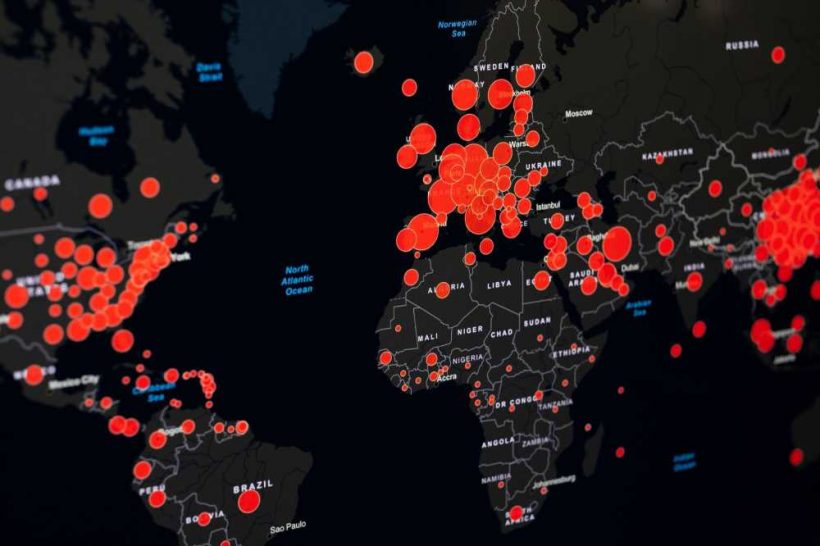
Could natural radon radiation have influenced the spread of the COVID-19 pandemic in Ukraine?
A new study published in Scientific Reports aimed to identify factors that could influence the pattern of the coronavirus disease 2019 (COVID-19) pandemic in a particular area.

It examined whether natural radon radiation influenced the spread of the COVID-19 pandemic in Ukraine, looking in particular at four regions in Ukraine that were considered to have experienced increased exposure to Radon, a decay product of Uranium.
Background
Improving existing vaccines and drugs is essential in the fight against the COVID-19 pandemic caused by severe acute respiratory syndrome coronavirus 2 (SARS-CoV-2). However, pulmonary complications and the limited efficiency of existing treatment options have fueled the interest in alternative therapies and following the patterns of COVID-19 spread.
Radon, a noble radioactive gas and one of the decay isotopes of uranium, produces one kind of natural radiation. Radon has been identified as “the most significant dose-forming factor” in the irradiation of the Ukraine population. During COVID-19 lockdowns, long indoor stays under increased radon irradiation in Ukraine were considered to be a risk factor for cancer.
Areas with high natural background radiation (HNBR), especially in China, Brazil, India, and Iran, have been assessed for health risks. However, compared to the control group, no significant increase in mortality in HNBR areas was found.
Generally, the quality of such studies depends on a number of factors, including sufficient statistical power and appropriate study design. Additionally, health statistics and cancer rates in HNBR countries are not well-documented.
In HBNR regions, expected health problems are hard to identify causally because such problems would exist to some degree, irrespective of radiation exposure. The COVID-19 pandemic has posed some interesting questions.
For instance, the number of cases in some regions of Ukraine (e.g., Kirovograd, Kherson, Vinnytsia) was definitely lower than in others. These regions feature increased natural radiation as they are located close to Ukraine’s uranium deposits.
About the study
This study analyzed the normalized system statistics on the development of COVID-19. The goal was to detect certain anomalies and/or regularities of this process, conditional on the geographical features of particular areas of Ukraine.
It was assumed that the level of health care was equal throughout the country. The main factor influencing the infection spread dynamics was considered to be population density. To reduce its impact, the densities were normalized by the average population density in Ukraine, resulting in a linear model in the form of a relationship between the size of the region and the normalized values of the number of COVID-19 cases.
Key findings
The normalization led to the identification of a number of regions with “abnormal” indicators of active COVID-19 cases. These regions formed a united area in the related basin of the Southern Bug, Ingulets, and Ingul. One could assume that the river beds of this basin have rocks of the same type.
Further, considering that 83% of Ukraine’s uranium deposits are concentrated in the nearby Kirovograd region, it could be argued that rocks near Kirovograd contain the same uranium, but in much lower quantities. This is also the region in Ukraine where the number of COVID-19 cases was the lowest.
Medical research continues to evaluate the role of radon in treating pulmonary diseases. Although radiation increases free radical production, it also activates their neutralization, preventing the expression of damaging actions of radicals. This potentially explains the beneficial effects of small doses of ionizing radiation.
Recent research has quantitatively evaluated the relationship between the tissue/organ absorbed dose and the biological response caused by radon.
The findings showed that a small amount of active oxygen generated from radon, was able to activate the biological defense system. As a result, it was suggested that the amount of medicine required could be reduced by combining drug and radon therapy.
The aforementioned findings could explain the low number of COVID-19 cases in the specific area of Ukraine around the uranium deposits. Compared to other regions of Ukraine, the morbidity and mortality indicators in these regions was also lower.
Conclusions
The results presented here have provided important information on the possible dependence of a number of COVID-19 cases on the geological conditions of a particular region. The findings are important for the development of healthcare services and prevention strategies to combat COVID-19.
It must be noted that the data considered in this study is incomplete, as the processing of data was interrupted by the armed conflict in February 2022. Owing to this lack of data, both at the local and national levels, the more proven parametric methods of mathematical statistics could not be used.
This will be the next step in this research agenda once peace is restored and relevant statistics can be accessed.
- Yelizarov M, et al. (2023). Influence of the natural radon radiation on the spread of the COVID 19 pandemic. Scientific Reports, 13(1), pp. 1-9. doi:/10.1038/s41598-023-39705-2. https://www.nature.com/articles/s41598-023-39705-2
Posted in: Medical Science News | Medical Research News | Miscellaneous News | Disease/Infection News
Tags: Cancer, Coronavirus, covid-19, Drugs, Health Care, Healthcare, Medical Research, Medicine, Mortality, Oxygen, Pandemic, Radiation Exposure, Research, Respiratory, SARS, SARS-CoV-2, Severe Acute Respiratory, Severe Acute Respiratory Syndrome, Syndrome

Written by
Dr. Priyom Bose
Priyom holds a Ph.D. in Plant Biology and Biotechnology from the University of Madras, India. She is an active researcher and an experienced science writer. Priyom has also co-authored several original research articles that have been published in reputed peer-reviewed journals. She is also an avid reader and an amateur photographer.